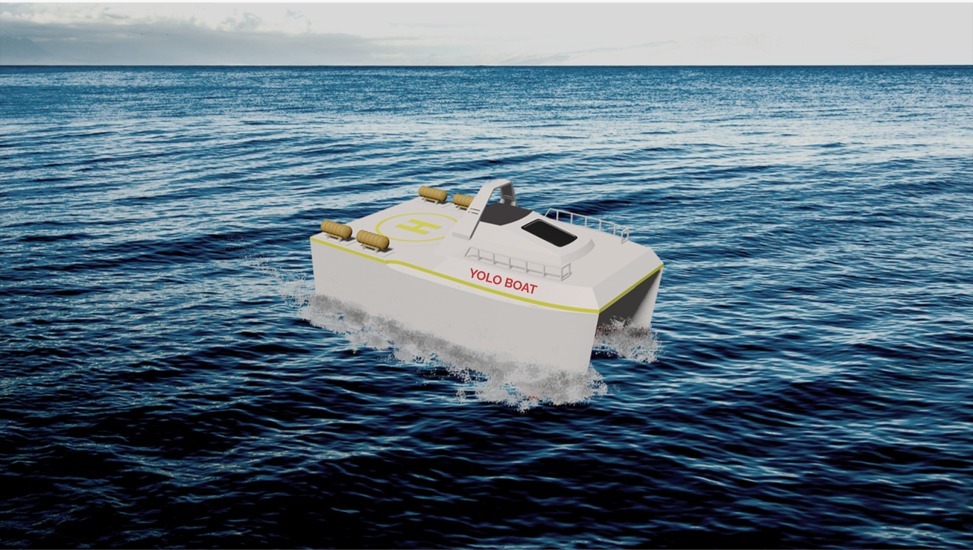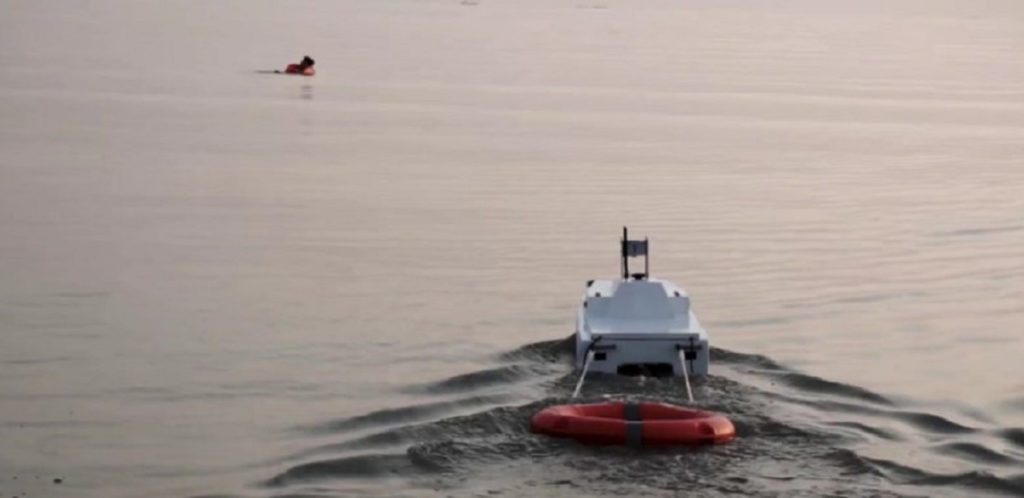ITS Students Create Boat Drone for Marine Rescue

The design of the YOLO-Boat, an autonomous boat drone for search and rescue missions based on computer vision, made by the ITS student team
ITS Campus, ITS News – Being a maritime country, Indonesia must have proficiency in evacuating victims if an accident occurs in the seas. Because of that concern, a student team from Institut Teknologi Sepuluh Nopember (ITS) created a computer vision-based autonomous boat drone for marine accident victims, called the YOLO-Boat.
Andreas Raja Goklas Sitorus, as the head of the YOLO-Boat design team, said they designed this innovation to help the Search and Rescue (SAR) team avoid danger during rescuing accident victims in the waters, especially at sea. Some factors can endanger the SAR team when carrying out rescues in the field, such as the weather and the location of the accident.
“Seeing this possibility, we are motivated to make a tool that can help rescue operations by the SAR Team,” said Andreas. This tool, continued Andreas, is designed to work independently in detecting victims to minimize the risk of danger in the rescue process.
They chose YOLO-boat from the famous acronym, You Only Live Once. They chose this name so that this boat could be a hope for the victims. “Often in the rescue process, seeing the victim for the first time is the only chance for the rescuer to help the victim; in other words, there is no second chance,” said Andreas. That is the meaning behind the naming of this rescue ship.
This Marine Engineering Department student explained that YOLO-Boat uses several technologies. YOLO-Boat uses a catamaran hull or double hull, where they have designed the hull to have good stability in carrying out its mission.

Testing the ability of the YOLO-Boat prototype, designed by the ITS student team, in detecting victims at sea
According to Andreas, the propulsion system uses an azimuth propulsion system to increase the YOLO-Boat’s maneuver in the water. “We also designed the electrical system as efficiently as possible, both from the control system and ship power management,” explained Andreas again.
Besides, Andreas said that YOLO-Boat uses the Robot Operating System (ROS) as the main framework in its operation. This ship uses several sensors that function to provide location and orientation data which they will later use in the guided navigation of the YOLO-Boat.
Using Computer Vision technology, they created a particular object detection model, namely the YOLOv4 architecture based on Convolutional Neural Network (CNN). “In its operation, computer vision is what identifies and allows YOLO-Boat to come to rescue victims,” explained Andreas.
Furthermore, Andreas explained that before being tested in the field, YOLO-Boat first tried its algorithm using a simulator to predict the implementation of rescue operations. “YOLO-Boat is also equipped with a User Interface system for parameter adjustment during testing and assisting in the monitoring process,” said the student, who is currently in his last year of college.
In its application, the YOLO-Boat must first be brought using a rescue ship to the waters designated as the accident site. Then the YOLO-Boat will be released into the sea and begin the process of searching for victims. The YOLO-Boat will give the victim a life jacket when the victim is detected.

The ITS student team who designed the YOLO-Boat rescue ship and their supervisor
Then. YOLO-Boat sends a signal to the rescue ship. The rescue ship can quickly come to the location of the victim found. “Ideally, many YOLO-Boats will work together to increase the effectiveness of rescue victims,” said Andreas.
The effectiveness of the YOLO-Boat in identifying victims is proven by its ability to detect victims even though the only part of the victim’s body that can appear on the sea surface is the face. This YOLO-Boat can operate for 44 minutes with a maximum distance of 6,780 meters.
“We have also had many discussions with the Indonesian National SAR Agency (BASARNAS) and accommodated inputs regarding the potential and weaknesses that may occur when the YOLO-Boat is used in the field,” admitted Andreas.
The prototype testing results at Kenjeran Beach show the success of completing YOLO-Boat. “YOLO-Boat was able to identify and secure the volunteers who recreated the role of drowning victims,” he said. Thanks to this extraordinary innovation, Andreas and his team also brought home a silver medal at the 2021 National Student Scientific Week (Pimnas) in the Program Kreativitas Mahasiswa Karsa Cipta (PKM-KC).
Apart from Andreas, this team also consists of Achmad Zidan Akbar from the 2018 Informatics Engineering Department, Nawab Aditya from 2019 Electrical Engineering, Rahyan Damar Ramadhan from Naval Systems Engineering 2019, and finally Zulieta Krisna Damayanti from Naval Engineering 2019. They take pride in all the time and effort put into this project. “We hope that our team can work again, especially in the development of autonomous vehicle models, not only in SAR operations but more broadly,” concluded Andreas. (nadh/ITS PR)
Reporter: Megivareza Putri Hanansyah
Related News
-
ITS Collaboration with BPBD East Java, Launching VR Disaster Simulation
ITS Campus, ITS News — Supporting anticipation of disasters and continuing to educate the public, Institut Teknologi Sepuluh Nopember
December 01, 2021 20:12 -
Supporting the Implementation of Innovative Ideas, ITS and IYSA Hold International Competition
ITS Campus, ITS News — Institut Teknologi Sepuluh Nopember (ITS) has once again proven its commitment to supporting the
December 01, 2021 20:12 -
ITS Maintains Informative Qualification for Five Consecutive Years at KIP Awards
ITS Campus, ITS News — Institut Teknologi Sepuluh Nopember (ITS) has once again successfully maintained its Informative Qualification predicate
December 01, 2021 20:12 -
ITS Strengthens Smart Eco-Campus through UI GreenMetric 2024
ITS Campus, ITS News — Institut Teknologi Sepuluh Nopember (ITS) has once again demonstrated its commitment to environmental concern
December 01, 2021 20:12
